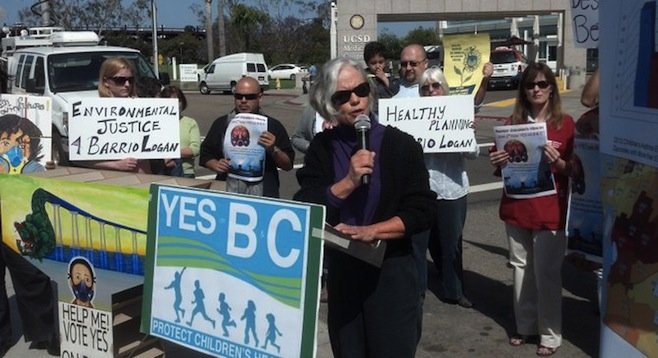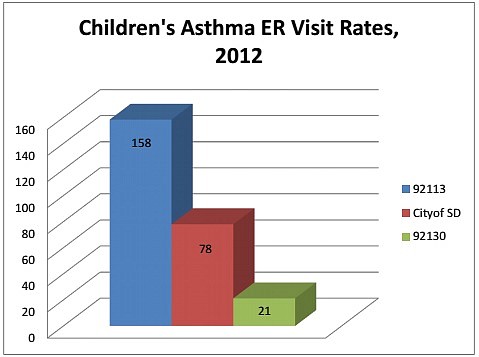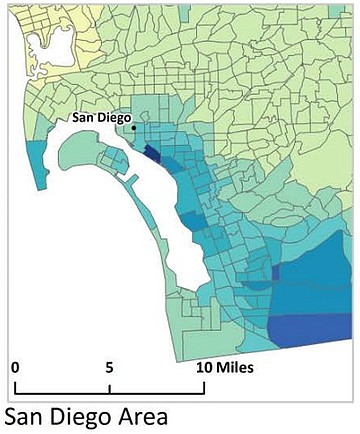 Facebook
Facebook
 X
X
 Instagram
Instagram
 TikTok
TikTok
 Youtube
Youtube

A group of labor and environmental activists gathered Wednesday morning, April 23, outside the UCSD Medical Center in Hillcrest to kick off a campaign in support of Propositions B and C, which will be put to voters citywide in June.
The sister propositions were placed on the ballot through a ethically questionable petition drive by the San Diego shipyard industry, which contends the changes to the community plan for Barrio Logan are cripplingly restrictive. A “yes” vote on B would confirm the approval of the plan, which has already been voted through in city council, and a “yes” on C would enact the zoning changes required to fully implement the plan, which calls for limited industrial growth in current mixed-use industrial/residential areas and a two-block "buffer zone" between heavy industrial (the shipyards) and residential use. The plan would shrink the overall area open to industrial use from 230 acres to 170 acres within the neighborhood.
"[The buffer] doesn't allow residential in some areas where the current plan allows," said Georgette Gomez, associate director of the Environmental Health Coalition, the group that unsuccessfully fought to have the propositions removed from the ballot. "It also won't allow businesses that will impact the health and safety of the residents next to residential property."

"It's hard for us to see children coming into the emergency room with respiratory issues," said Michael Jackson, a representative of the California Nurses Association union. "No child deserves to struggle to breathe."
Community-plan proponents provided a chart indicating emergency-room visits for children in Barrio Logan were twice as high as the citywide average in 2012, and as much as seven times higher than in inland suburbs.
Joy Williams, research director at the Environmental Health Coalition, said the community plan's implementation was vital to protect the health and safety of Barrio Logan residents.
"Asthma has many causes, and air pollution is just one of them, but it's a factor we can mitigate with good land-use planning," said Williams.

A media release distributed at the press conference included charts indicating 27.6 million pounds in hazardous waste is generated by area maritime industries annually, and a map released this week by the California Environmental Protection Agency ranks Barrio Logan at the top of all San Diego communities in terms of concentrations of chemicals released.
"Opponents of the Barrio Logan plan update would like you to believe all of the pollution is from the freeway," Williams continued, "but data submitted to the federal government by the businesses themselves shows this is not true."


A group of labor and environmental activists gathered Wednesday morning, April 23, outside the UCSD Medical Center in Hillcrest to kick off a campaign in support of Propositions B and C, which will be put to voters citywide in June.
The sister propositions were placed on the ballot through a ethically questionable petition drive by the San Diego shipyard industry, which contends the changes to the community plan for Barrio Logan are cripplingly restrictive. A “yes” vote on B would confirm the approval of the plan, which has already been voted through in city council, and a “yes” on C would enact the zoning changes required to fully implement the plan, which calls for limited industrial growth in current mixed-use industrial/residential areas and a two-block "buffer zone" between heavy industrial (the shipyards) and residential use. The plan would shrink the overall area open to industrial use from 230 acres to 170 acres within the neighborhood.
"[The buffer] doesn't allow residential in some areas where the current plan allows," said Georgette Gomez, associate director of the Environmental Health Coalition, the group that unsuccessfully fought to have the propositions removed from the ballot. "It also won't allow businesses that will impact the health and safety of the residents next to residential property."

"It's hard for us to see children coming into the emergency room with respiratory issues," said Michael Jackson, a representative of the California Nurses Association union. "No child deserves to struggle to breathe."
Community-plan proponents provided a chart indicating emergency-room visits for children in Barrio Logan were twice as high as the citywide average in 2012, and as much as seven times higher than in inland suburbs.
Joy Williams, research director at the Environmental Health Coalition, said the community plan's implementation was vital to protect the health and safety of Barrio Logan residents.
"Asthma has many causes, and air pollution is just one of them, but it's a factor we can mitigate with good land-use planning," said Williams.

A media release distributed at the press conference included charts indicating 27.6 million pounds in hazardous waste is generated by area maritime industries annually, and a map released this week by the California Environmental Protection Agency ranks Barrio Logan at the top of all San Diego communities in terms of concentrations of chemicals released.
"Opponents of the Barrio Logan plan update would like you to believe all of the pollution is from the freeway," Williams continued, "but data submitted to the federal government by the businesses themselves shows this is not true."
Comments